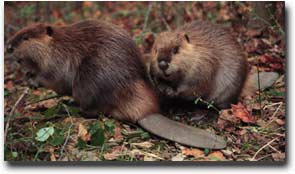
Reproduction and Life History
Beavers reproduce sexually. Although genetalia look identical for both sexes on the outside, they can be identified by the oil that is produced by the oil glands located near the anus. For females, the color of the oil is a pale yellow while for males it has a coppery brown tint. Once two beavers find mates, they stay with each other for their entire life most of the time. The only time they find another mate is when their mate dies. If this were to happen, the young that belong to the mother may not be accepted by the mother’s new mate. A female typically becomes sexually active by the time she turns two years old. The climax of the breeding time is during the middle of the month of February. Beavers are then born in the spring due to the fact that the gestation period is somewhere around 110 days.
The mother takes care of the young on her own when they are born; the father moves out until the young beavers are developed. When the young are born, they weigh about a pound each. There are between two and four young in each litter, which is suitable because females have four nipples so they can nurse only four at a time. A beaver colony includes the mother, the father, the yearlings and the newly born. There are usually up to ten beavers in a colony. The young develop at a quick rate. The day they are born they are able to walk on four feet and they can swim and explore the habitat soon after. The mother’s milk consists of 11.2% protein and 19% fat. It has 92.46 kcal/ gram of energy on average. By the time they are a month old they no longer need the nutrition of their mother’s milk and are able to eat solid food. When they are completely weaned, they weigh around 4 pounds. The mother works incredibly hard making numerous trips back and forth to get food for the young. They interact with their mother at great distances by making a high-pitched whining sound. When they begin to go out and search for food on their own, they have to learn to watch for predators, as they are unable to dive quickly under the water if they have to escape. After a beaver has spent his or her second winter with the family, it is time to venture off and find a mate of his or her own.
Although there are only two species of beavers extant today, fossil records show that this was not always the case. Castor ohioensis is a species of beaver that is extinct today. This beaver was up to six times larger than the average beaver today and was the size of a black bear! This beaver was found in Ohio. Another ancestor, Castor californiensis, was found in California. This beaver, on the other hand, was smaller than the average beaver today (about the size of a muskrat). Fossils have also shown that during the Pleistocene age, beavers migrated between Eurasia and North America. Until around 10,000 years ago, both of the extant species of beaver existed with these extinct species. In the past, the beaver was appreciated for things that they are no longer as valued for today. Although they are still admired for their fur, they used to also be used for medical ingredients, perfume, and meat as well.

